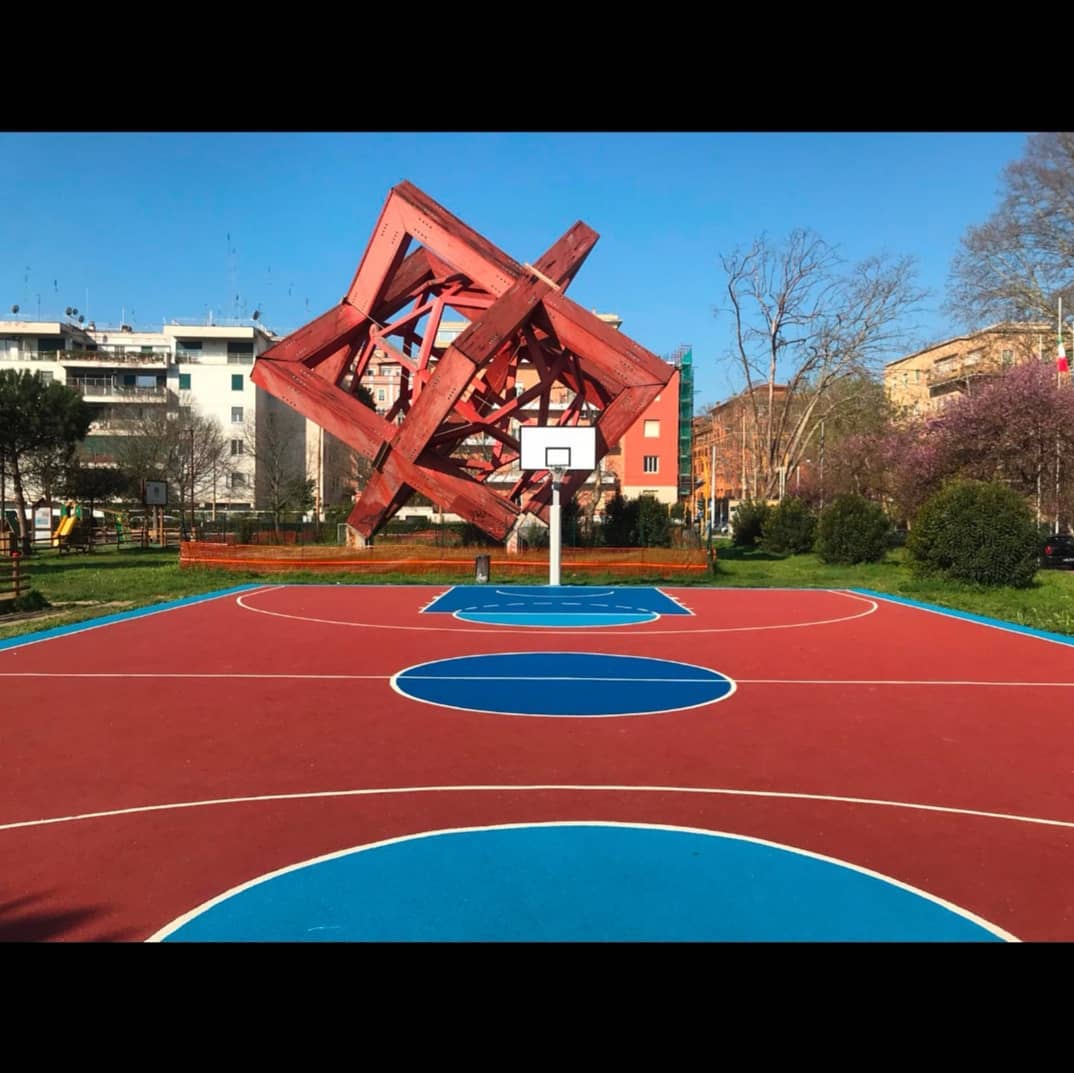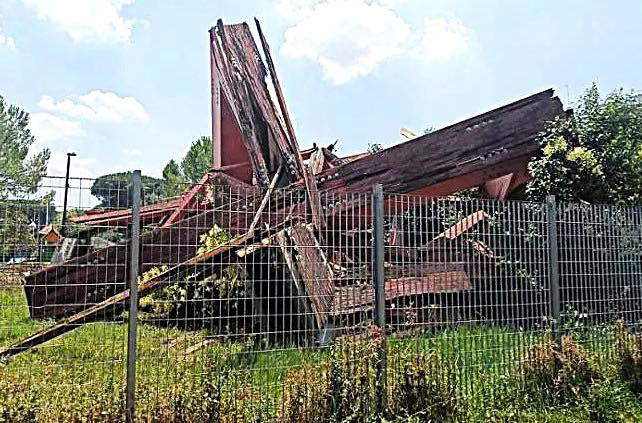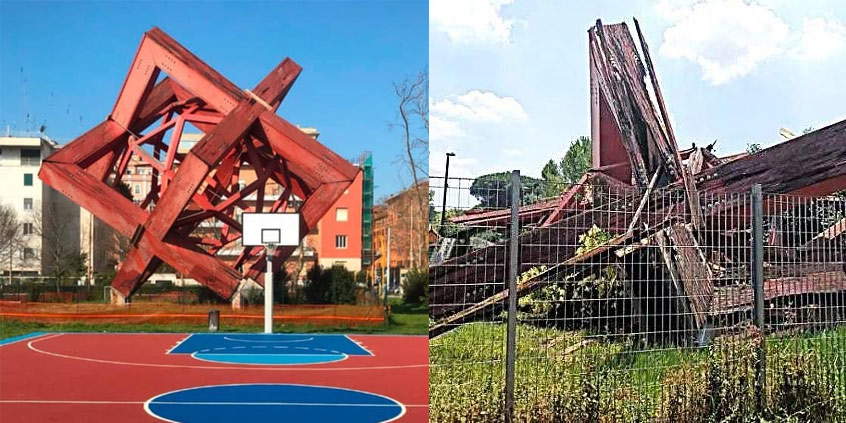In Rome, in the heart of the Flaminio district, the famous Goal sculpture created by Mario Ceroli (Castel Frentano, 1938) for the Italia ’90 World Cup collapsed. A monumental work, about 16 meters high, which for more than 30 years represented not only an artistic icon but also a cultural symbol of that historic World Cup hosted by Italy. For some time, however, it had been in a very dilapidated condition.
The collapse caused a great stir among art lovers, sportsmen and Roman citizens, who saw a piece of collective memory crumble. Goal, made entirely of wood, had been conceived by Mario Ceroli specifically to celebrate the 1990 World Cup. Sixteen meters tall and imposing, it represented a tribute to soccer and its symbolic power, and was initially located in front of the PalaEur, after which, in 2001, it was moved to an urban context rich in history and culture, the Flaminio district, a short distance from the Palatiziano and close to the Olympic Stadium, the epicenter of those sporting events. Ceroli, an internationally renowned artist, had created a work capable of dialoguing with public space, merging art, sport and historical memory.
The sculpture had become a landmark not only for the inhabitants of the area but for the entire city of Rome. Over the years, Goal had withstood the weather and the wear and tear of time, but evidently not without difficulty. The wooden structure, subject to severe deterioration, would show signs of fragility.

The collapse occurred on June 23, 2025. The sculpture suddenly crumbled, probably due to a structural failure that made the giant installation unstable. Fortunately, there are no reports of injuries or personal damage, given the generally sparse area in the early morning hours when the collapse occurred, but the material and symbolic damage is enormous.
The causes of the collapse are still being ascertained, but it is speculated that the main culprit is the lack of proper maintenance, which would have been a major contributor. Wood, a living material subject to natural deterioration, can lose integrity and safety if not constantly treated, compromising the stability of the work. Despite its artistic and historical value, the sculpture would indeed seem not to have received the necessary attention from institutions or public heritage managers.
Many citizens and art lovers, after all, have long complained about the lack of regular maintenance and a safeguard plan that could preserve such an important work. The risk, after all, is that similar episodes may be repeated if urgent action is not taken to protect the national cultural heritage. The case of the Goal sculpture thus becomes a warning to local and national governments to seriously consider the care of outdoor works of art.
Speaking to RomaToday, Rino Fabiano, councillor for the environment of Rome’s 2nd municipality, says, “This affair highlights the serious delays on the part of the Capitoline Superintendency, which has never taken a proactive stance when emergencies such as this arise. The municipality signaled the dangerousness of the work in 2015, there were junta notes and council acts calling for the work to be either moved, or downsized. Ceroli, who is now 87 years old, had also made himself available to find a solution. But the Superintendency ignored us and, indeed, had budgeted 300,000 euros to recover it. Money for me thrown away, how do you restore a work now rotten from time, neglect and weathering, next to a playground and play area? In any case, ten years have passed, nothing has been done. It would have been better to avoid this collapse. As much as the Superintendence is a very important body in Rome, it fails to intervene on time and in the proper manner when necessary, as Villa Mercede, the Aurelian Walls still propped up in San Lorenzo after five years, and now the Palatiziano work teach.”

Goal was not just a monumental structure, but a powerful symbol, embodying the passion for soccer and Italian sports culture, as well as the artistry of Mario Ceroli, known for his innovative use of wood and ability to create installations capable of dialoguing with urban space. The sculpture called to mind that unique historical moment of the 1990 World Cup, an event that had united Italy in an atmosphere of enthusiasm and sporting celebration.
The fall of this icon, in addition to representing an artistic loss, stands as a wound in the collective memory and cultural narrative of the city of Rome. The work embodied an era and an identity that are now in danger of being lost unless concrete recovery and restoration measures are put in place. In the aftermath of the collapse, investigations and surveys have been launched to assess the extent of the damage and decide the future of the sculpture. Local and cultural administrations will be faced with the difficult choice of whether to attempt a restoration-which could prove complex and costly-or to proceed with a refurbishment or even permanent removal.
The hope is that, thanks in part to the media attention generated by the incident, a broader enhancement and protection project can be set in motion. The hope is that Mario Ceroli’s sculpture can once again be admired and celebrated.
 |
| Rome, Goal, Mario Ceroli's sculpture symbolic of the Italia 90 World Cup, collapses |
Warning: the translation into English of the original Italian article was created using automatic tools. We undertake to review all articles, but we do not guarantee the total absence of inaccuracies in the translation due to the program. You can find the original by clicking on the ITA button. If you find any mistake,please contact us.